Breastfeeding: Was there ever a golden age?
- Published
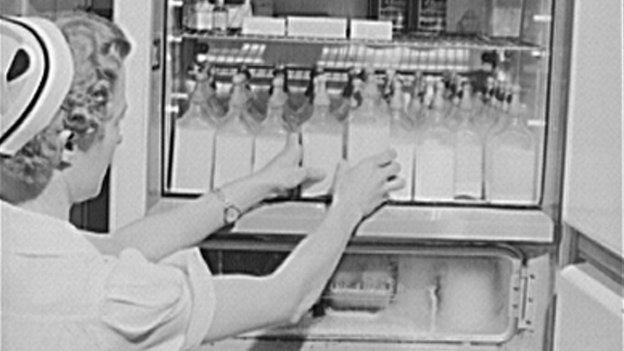
A nurse arranges formula bottles in 1942
Before she went on maternity leave, a British politician called for a detente in the culture wars surrounding breastfeeding. Breast is best, as the saying goes, but it has never been the only option - terracotta pots, donkey's milk and soaked bread have played their part in a varied history.
"There is, I think, far too much guilt generally in society around parenthood, about whether or not you breastfeed or whether or not you bottle feed," says the UK's Liberal Democrat equalities minister Jo Swinson, calling for people to be respectful, external of other choices.
It's a choice with a long history.
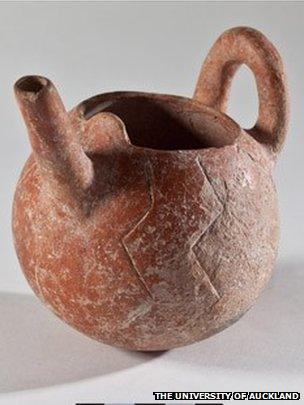
This 4,000-year-old baby feeder was found at a car boot sale and donated to the University of Auckland
As long as there have been babies, there have been breastfeeding mothers, providing infants with basic, essential nutrition.
But for a surprisingly long time, there have also been baby bottles, used to feed infants when mothers couldn't.
"We talk about the golden age where everybody breastfed, and that age never happened," says Suzanne Barston, author of Bottled Up: How the Way We Feed Babies has Come to Define Motherhood, and Why it Shouldn't.
When a mother died in childbirth or was unable to breastfeed, infants throughout the centuries have been fed by wet nurses. But others relied on dry-nursing, or feeding a baby without the breast.
"There's archaeological evidence right down to the ancients of bottles of various kinds and alternative feeding methods," says Ellie Lee, director of the centre for parenting cultural studies at the University of Kent.
Then, as now, breastfeeding was not always an option.
"If a woman had a hard delivery, if she was sick after, if the milk didn't come in or there was a nasty abscess, any health-related reasons might prevent them from being able to breastfeed," says Nora Doyle, a visiting lecturer of history at the University of North Carolina.
Moreover, says Dr Lee, "There have always been working mothers." This includes the wet nurses themselves, who often left their children at home so they could feed the babies of more privileged women.
In the 1950s, the London physician Ian G Wickes published a multi-part compendium of feeding practices throughout history, including the changing technology that allowed families to dry feed, a practice also often called hand-feeding.
In ancient history, infants were fed with terracotta pots with long spouts, which were sometimes included in infant graves. Europeans around the time of the Renaissance outfitted cows' horns with leather nipples, while small vessels with elaborate china patterns or crafted in pewter or silver were used in the 18th and 19th Centuries. Rags were often used to help facilitate feeding and distract the baby.
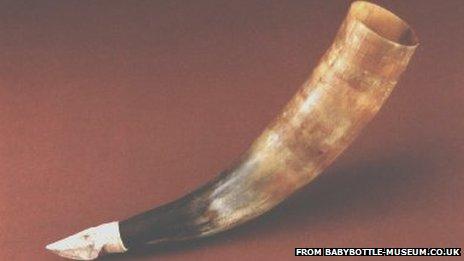
A horn repurposed as a baby feeding device
"There can be little doubt that breast milk was by no means the only food commonly given to young infants," writes Wickes in his collection of the earliest evidence of non-breastfed infants. But what those infants drank could vary depending on time and culture.
Infants in ancient Greece were fed wine and honey, while Indian children in the second Century AD were given "diluted wine, soups and eggs" at six months of age.
In the US, donkey's milk was often seen as a suitable alternative to breast milk.
The practice of suckling an animal - as the twins Romulus and Remus did in Roman mythology - was also employed. As documented in the book Milk: A Local and Global History, 15th-Century French women relied on goats to feed their infants when wet nurses were cast out of favour following a syphilis outbreak.
The most common breast milk substitution was pap or panada, watery mixtures with questionable nutritive value.
"To be honest, they were feeding infants weird stuff," says Dr Doyle, "milk, flour, melted butter or a meat-based broth. It was a peculiar mixture of things that are liquid, and sometimes had a bit of bread soaked in as well."
Hand-feeding came at a price.
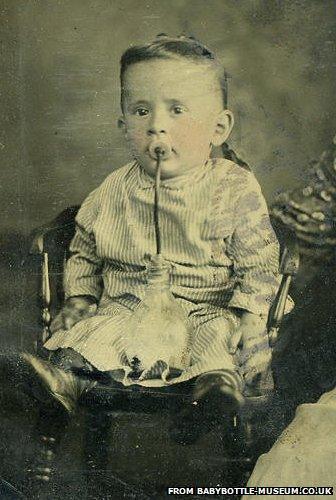
A child drinks from a 19th Century "banjo bottle", with glass tube and rubber stopper. Difficult to properly clean, it was later decried by doctors.
"Babies that were hand-fed tended to die," says Doyle. For most of history, "they didn't know about germs, so they were not sterilising" the tools used to feed babies, or keeping fresh the liquids used in place of breast milk.
It was the relative instability of these hand-feeding methods, along with an explosion of infant deaths accompanying the immigration and employment booms of the industrial revolution, that led physicians to seek a safer way.
"When more women were joining the workforce, whether they wanted to or not, a lot of babies were being left without someone to nurse them," says Barston. These children were hand-fed using unsanitary pap boats or hard-to-clean bottles, and often being fed cows' milk gone bad.
Paediatricians, an emerging class of doctors looking to make their mark, pushed for a medically sound method to feed these children. Formula was manufactured as a result.
"It used to be that if you couldn't breastfeed, your child did not have great prospects. Formula was a godsend," says Barston.
In the beginning half of the 20th Century, condensed milk was also a popular choice for western women who did not breastfeed. The advent of sterile bottles in the 1950s, combined with a cultural preference for the new and scientific, led to an increase in formula use. That produced a major sea change in the health of non-breastfed babies.
"There are now no safety issues associated with bottle feeding," says Dr Lee of Kent University. "What babies were being fed made them sick. Now nobody's getting ill."
That's a change that would have been welcomed by women in the 18th and 19th Centuries, says Dr Lee.
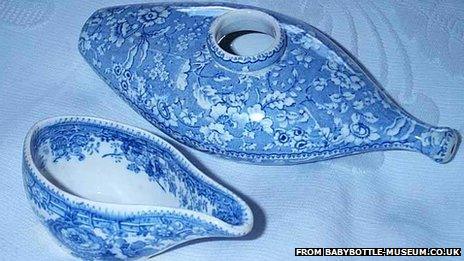
Wedgwood pap feeders
"The women I see [in history] are very practical. They expect and want to breastfeed, but they are very upfront about when it hurts, when it goes wrong, and when they need to give up and find a wet nurse," she says.
"They may not be happy about it, but if you have a baby you want to keep it alive." That means feeding by any means necessary.
The debate over formula use still simmers despite the calls for peace from people like Swinson. But it's clear that for everything that formula may not be - best for babies, nutritionally equal to breast milk, inexpensive - it is, above all, a safe way to feed growing infants.
Follow @BBCNewsMagazine, external on Twitter and on Facebook, external